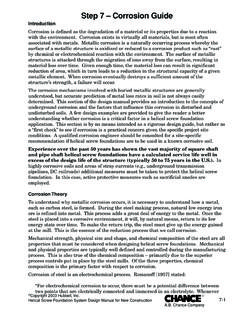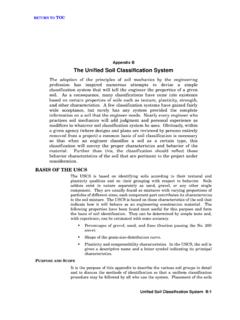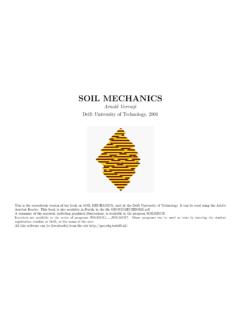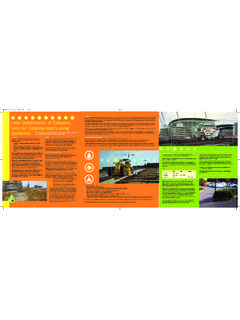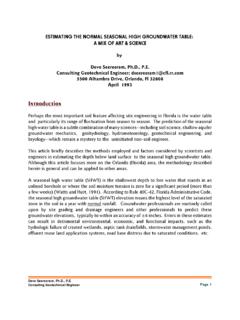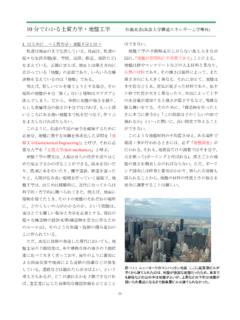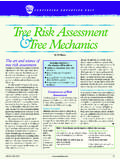Transcription of Step 2-Soil Mechanics - Vickars
1 Copyright 2003 Hubbell, Screw Foundation System Design Manual for New Construction Chance Company2-1 step 2 soil MechanicsIntroductionWebster defines the term Mechanics as a branch of physical science that deals with energyand forces and their effect on bodies. soil Mechanics is the branch of Mechanics that dealswith the action of forces on soil masses. The soil that occurs at or near the surface of theearth is one of the most widely encountered materials in civil, structural and architecturalengineering. soil ranks high in degree of importance when compared to the numerousother materials ( steel, concrete, masonry, etc.) used in is a construction material used in many structures, such as retaining walls, dams, andlevees. soil is also a foundation material upon which structures rest. All structures,regardless of the material from which they are constructed, ultimately rest upon soil orrock.
2 Hence, the load capacity and settlement behavior of foundations depend on thecharacter of the underlying soils, and on their action under the stress imposed by thefoundation. Based on this, it is appropriate to consider soil as a structural material, but itdiffers from other structural materials in several important is a manufactured material whose physical and chemical properties can be veryaccurately controlled during the manufacturing process. soil is a natural material, whichoccurs in infinite variety and whose engineering properties can vary widely from place toplace even within the confines of a single construction project. Geotechnical engineeringpractice is devoted to the location of various soils encountered on a project, thedetermination of their engineering properties, correlating those properties to the projectrequirements, and the selection of the best available soils for use with the variousstructural elements of the , steel is a material whose properties generally remain unchanged during the lifeof a structure.
3 The properties of soils can change as the amount of moisture fluctuates andother environmental influences vary. Soils can change significantly under load. Forexample, loading can increase soil density and strength if pore pressure is allowed todissipate. If pore water cannot escape, loading may drastically weaken the soil becausethe pore water, which has no shear strength, bears the load. These possible changesrequire the geotechnical engineer to predict soil behavior under anticipated load whetherthe load is applied gradually or Karl Terzaghi stated in his 1943 book titled Theoretical soil Mechanics : .. the theories of soil Mechanics provide us only with a working hypothesis,because our knowledge of the average physical properties of the subsoil and of theorientation of the boundaries between the individual strata is always incompleteand often utterly inadequate.
4 Nevertheless, from a practical point of view, theworking hypothesis furnished by soil Mechanics is as useful as the theory ofstructures in other branches of civil engineering. Advance planning and careful observation by the engineer during the construction processcan help fill in the gaps between working hypothesis and fact. This section of the designmanual intends to provide a basic understanding of soil Mechanics so the engineer candevelop a useful working hypothesis for the design and use of helical screw soil ProfileRock or soil material, derived by geologic processes, is subject to physical and chemicalchanges brought about by the climate and other factors prevalent at the location of thesoil. Vegetation, rainfall, freeze/thaw, drought, erosion, leaching, and other natural2-2 Copyright 2003 Hubbell, Screw Foundation System Design Manual for New Construction Chance Companyprocesses result in profound changes graduallytaking place in the character of the soil withthe passage of time.
5 This development bringsabout the soil soil profile is a natural succession ofzones or strata below the ground surface. Itmay extend to various depths, and eachstratum may have various thicknesses. Theupper layer of the profile is typically rich inorganic plant and animal residues mixed witha given mineral-based soil . soil layers belowthe topsoil can usually be distinguished by acontrast in color and degree of physical properties of each layer usuallydiffer from each other. Topsoil is seldom usedfor construction. Deeper layers will havevarying suitability, depending on theirproperties and location. It is important torelate engineering properties to individual soillayers in order for the data to be data from several layers of varying strengthare averaged, the result can be misleadingand meaningless. Equally misleading is thepractice of factoring a given soil s engineeringproperties for design.
6 This can lead to overlyconservative foundation soil ProfileTop SoilClaySiltSandGravelBed RockDefinition of SoilSoil is defined as sediments or other accumulation of mineral particles produced by thephysical or chemical disintegration of rock, plus the air, water, organic matter, and othersubstances that may be included. soil is typically a non-homogeneous, porous, earthenmaterial whose engineering behavior is influenced by changes in moisture content origin of soil can be broken down to two basic types: residual, and soil is caused by the weathering (decomposition) of rock by chemical or physicalaction. Residual soils may be very thick in areas of intense weathering such as the tropics,or they may be thin or absent in areas of rapid erosion such as steep slopes. Residual soilsare usually clayey, and their properties are related to climate and other factors prevalentat the location of the soil .
7 Residual soils are usually preferred to support foundations, asthey tend to have better, more predictable engineering or deposited soils are derived by the movement of soil from one location to theother by natural means. The means are generally wind, water, ice, and gravity. Thecharacter of the resulting deposit often reflects the modes of transportation and depositionand the source material. Deposits by water include alluvial floodplains, coastal plains, andbeaches. Deposits by wind include sand dunes and loess. Deposits by melting ice includeglacial till and outwash. Each of these materials has behavioral characteristics dependenton geological origin, and the geological name, such as loess, conveys much useful Copyright 2003 Hubbell, Screw Foundation System Design Manual for New Construction Chance Company2-3information. Transported soils particularly by wind or water are often of poor qualityin terms of engineering Volume & Density RelationshipsA soil mass is a porous material containing solid particles interspersed with pores or voids may be filled with air, water, or both.
8 Figure shows a conceptual diagramof relative volumes of air, water, and soil solids in a given volume of soil . Pertinentvolumes are indicated by symbols to the left while weights of these material volumes areindicated by symbols to the right. Figure also provides several terms used to definethe relative amounts of soil , air, and water in a soil mass. Density is the weight of a unitvolume of soil . It is more correctly termed the unit weight. Density may be expressedeither as a wet density (including both soil and water) or as a dry density ( soil only).Moisture Content is the ratio of the weight of water to the weight of soil solids. Porosity isthe ratio of the volume of voids to the total volume of the soil mass regardless of theamount of air or water contained in the voids. Void ratio is the ratio of the volume of voidsto the volume of soil particles.
9 The porosity and void ratio of a soil depend upon the degreeof compaction or consolidation. For a particular soil in different conditions, the porosityand void ratio will vary and can be used to judge relative stability and load-carryingcapacity stability and load capacity increase as porosity and void ratio decrease. Ifwater fills all the voids in a soil mass, the soil is said to be or hydraulic conductivity is the property of soil allowing it to transmit value depends largely on the size and number of the void spaces, which in turn dependson the size, shape, and state of packing of the soil grains. A clay soil can have the same2-4 Copyright 2003 Hubbell, Screw Foundation System Design Manual for New Construction Chance Companyvoid ratio and unit weight as a sand soil , but the clay will have a lower permeability be-cause of the much smaller pores or flow channels in the soil structure.
10 Water drains slowlyfrom fine-grained soils like clays. As the pore water drains, clays creep, or consolidateslowly over time. Sand soils have high permeability, thus pore water will drain quickly. Asa result, sands will creep, or consolidate when loaded until the water quickly drains. Afterdrainage, the creep soil TypesAs stated above, soil is typically a non-homogeneous material. The solid mineral particlesin soils vary widely in size, shape, mineralogical composition, and surface-chemicalcharacteristics. This solid portion of the soil mass is often referred to as the soil skeleton,and the pattern of arrangement of the individual particles is called the soil sizes of soil particles and the distribution of sizes throughout the soil mass areimportant factors which influence soil properties and performance. There are two basicsoil types that are defined by particle size.

